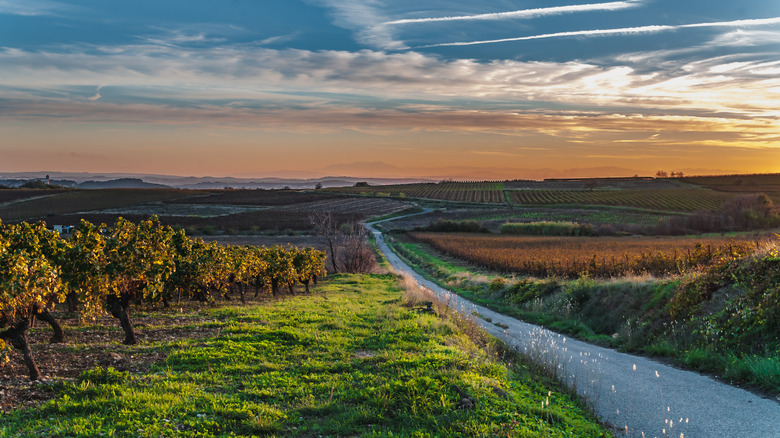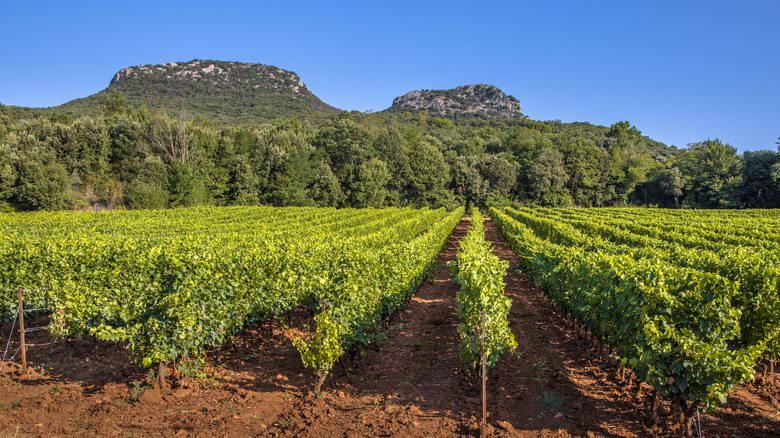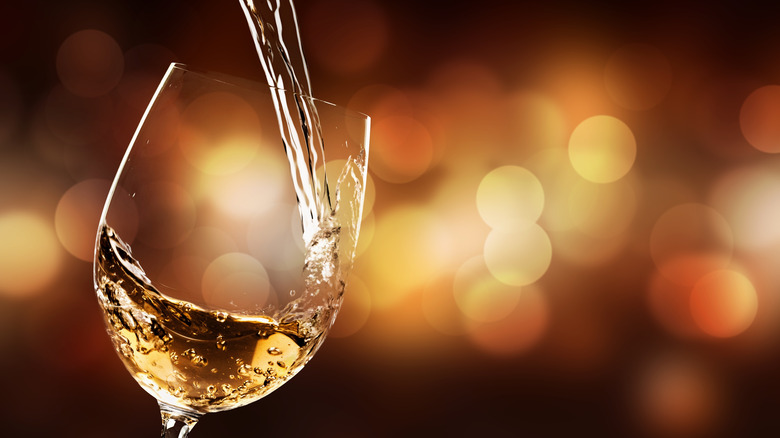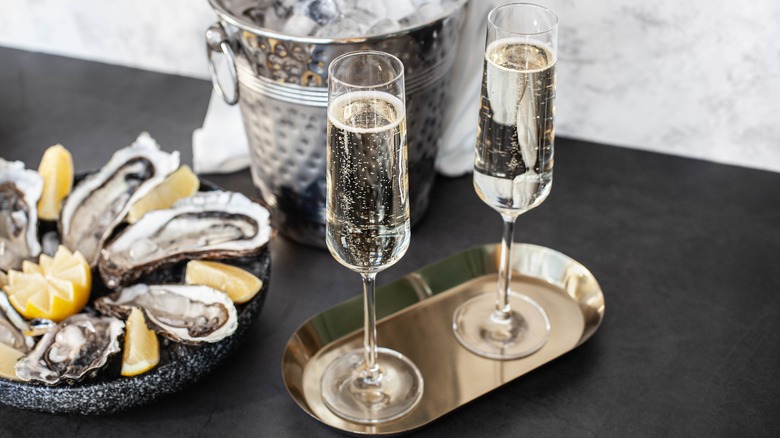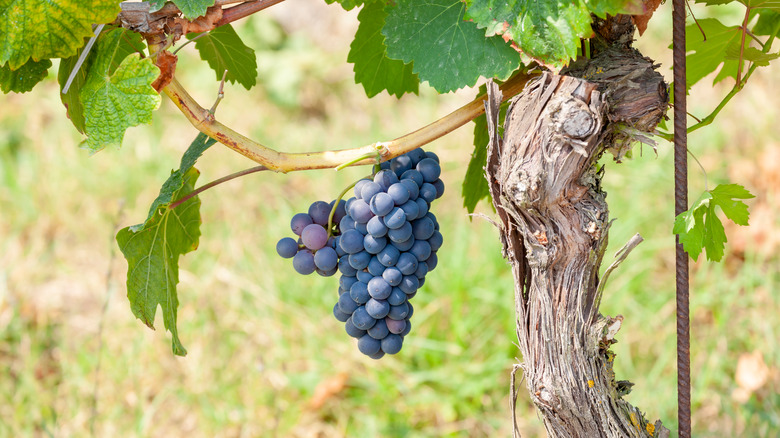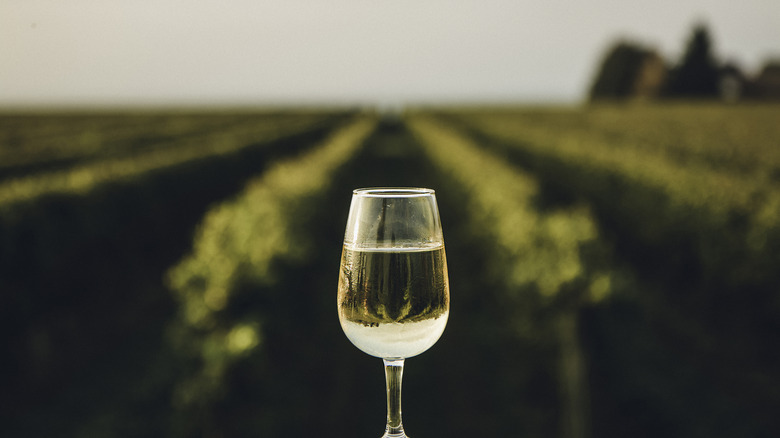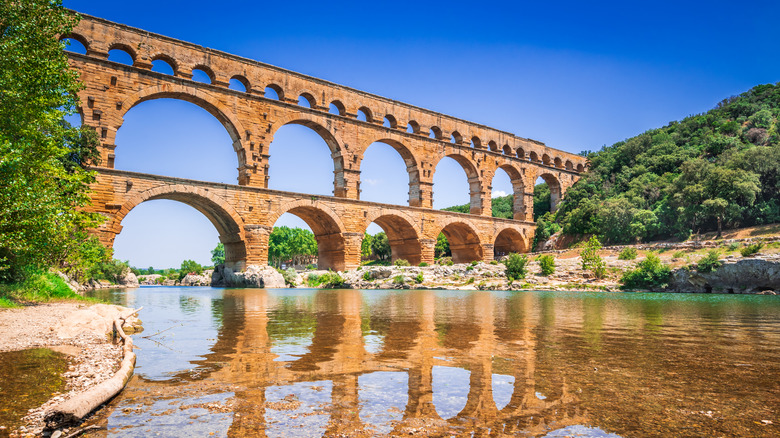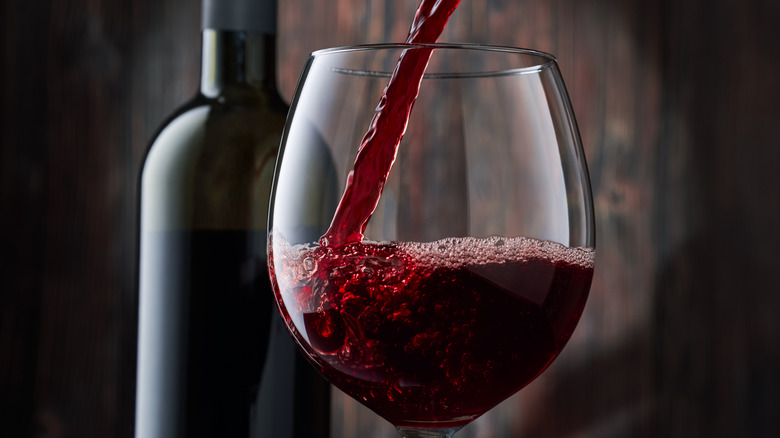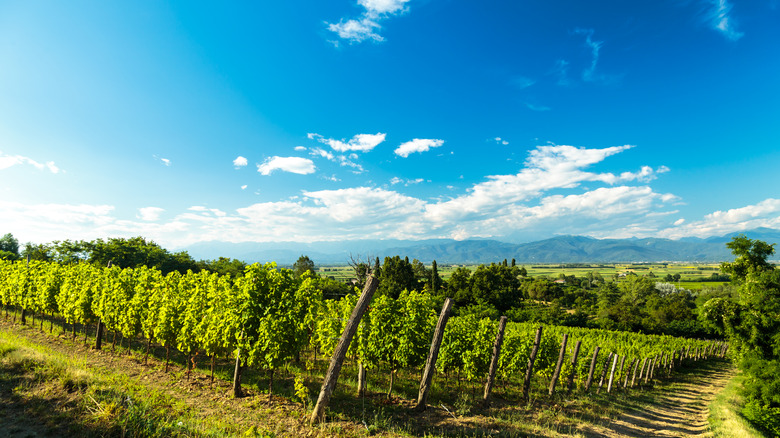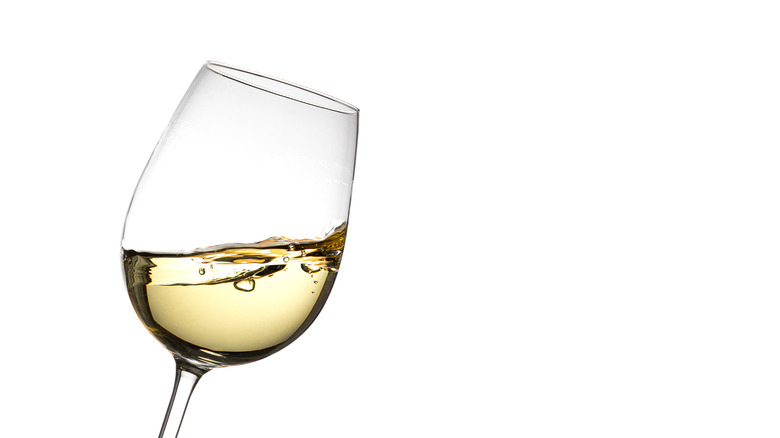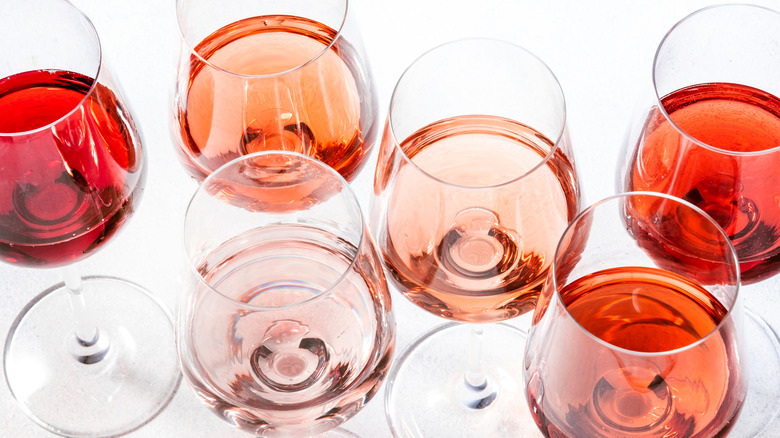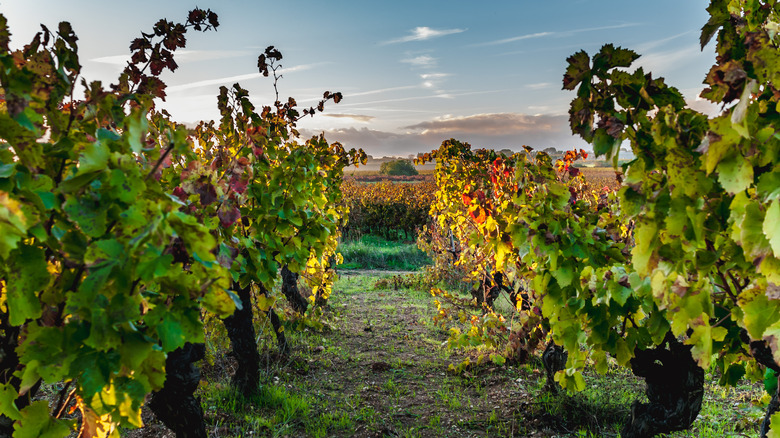The Beginner's Guide To Languedoc Wines
If you're new to French wine, you may assume that it's all about Burgundy and Champagne. But, beyond the country's priciest vineyards lies a wine landscape that's just as enjoyable (and often a lot more affordable) as the ultra-famous stuff. One particular region to keep on your radar is Languedoc. Wine Folly calls it a "value wine region," which means that enthusiasts can find top-quality wines for affordable prices. This isn't necessarily budget wine, though — wine lovers can find an array of premium wines without the shocking price tags.
According to Olivier Legrand, General Director of the Conseil Interprofessionnel des Vins du Languedoc, what sets Languedoc wines apart from other French wines is "energy and balance, drinkability and immediate pleasure." From this hot climate, you'll find a variety of reds, whites, and rosés that offer a surprising freshness and acidity despite the region's heat. Let's take a closer look at what Languedoc wines have to offer curious wine consumers.
Languedoc features a range of climates and wine styles
While some wine climates are relatively small and compact, resulting in one or just a few styles of wine, Languedoc has more going for it in terms of climate. That means it can produce a wider range of styles than smaller regions. According to Seven Fifty Daily, the climate in the mountains of Languedoc is similar to that of Rhône where the ocean influence plays a role and bright sunshine helps to ripen grapes. The center of the region has a more typical Mediterranean climate, while the western portion provides the ideal climate for producing sparkling wines.
According to advanced sommelier Erik Segelbaum: "People tend to think that Languedoc is a purely coastal, hot Mediterranean region." However, he says, "While some of Languedoc's appellations are indeed on the Mediterranean coast, much of the region is either inland, at a higher elevation or both. Wines from Languedoc often have great natural acidity and are bright and fresh, even the reds. It's hard to believe that Mediterranean reds can be so refreshing but in Languedoc that is almost always the case."
It can be difficult to find a region that produces such a wide range of styles appealing to a slew of different wine drinkers with different tastes, but Languedoc offers just that.
Languedoc is known for its red blends
Of course, Languedoc is not a monolith. There's so much going on in this region that it's hard to pinpoint one specific style of wine that Languedoc is known for. However, according to Olivier Legrand, the region is most known for its red, which accounts for 65% of the area's production. Much of these red wines are made from popular international varieties, but other black varieties have been gaining ground over the last several years. Some of these black grape varieties include Counoise, Piquepoul Noir, Terret Noir and Rivairenc (or Riveirenc). "Languedoc is hurtling headlong towards bold, bright red wines, which are now taking off," says Legrand.
It is possible to find varietal wines from Languedoc, but according to Wine Folly, the region really is all about the blends, which allows winemakers to experiment with different grapes and techniques to make unique wines that aren't found elsewhere in the world. According to Wine Folly, these red blends are more full-bodied and fruit forward.
Languedoc offers exciting dry white wines
Although Languedoc may be famed for its reds, that doesn't mean you should be overlooking its white wines. Per Olivier Legrand, white wines currently account for 23% of the appellation production. However, this was not always the case. Before phylloxera, a pest that caused the widespread destruction of vineyards in Europe in the mid-1800s, the majority of Languedoc's production was white wines. Legrand says that under Napoleon, whites "represented the majority of planting."
According to Legrand, the "whites are the rare gems, running the gamut from energetic to complex; they are wines of character." Languedoc whites can be made in both still and sparkling styles, so there's something for everyone. Wine Folly says that most of the region's white wines are made from picpoul and grenache blanc grapes. It's unusual to find picpoul outside of Southern France, so the protected wine region, or AOP, Picpoul de Pinet is definitely worth checking out if you like fresh and zesty whites.
Crémant de Limoux offers sparkling wine (and is actually older than Champagne)
Sparkling wine lovers have plenty to love about Languedoc. While Champagne might get much of the love in France, that doesn't mean you should overlook crémant, which translates to creamy, especially when it comes to Crémant de Limoux, a sparkling wine that comes from the foothills of the Pyrenees, according to Wine Searcher. In the past, these wines were generally made from the grape mauzac, says Wine Searcher, but these days, it's more common to see them made from chenin blanc and chardonnay.
Generally, sparkling wine is made in cooler climates, so it may come as a surprise that crémant can be so successful in Languedoc. But, this is where Languedoc's wide range of climates come in handy. Wine Searcher says that the cooler vineyards of Limoux, which are at a higher altitude than much of the surrounding area, are perfect for producing sparkling wines.
And if you're still loyal to your Champagne simply due to tradition, then it may interest you to know that Crémant de Limoux actually came onto the scene earlier than Champagne. Reuters reports this kind of crémant is France's oldest sparkling wine.
Many Languedoc producers have freedom to experiment
European wine regions are known for their often-strict appellation laws that determine how wines are labelled, what kinds of grapes can be grown, and the techniques wine makers are allowed to use in the cellar. While some regions have especially stringent laws, some producers from Languedoc have a bit more leeway when it comes to what kinds of wine they want to produce.
According to Olivier Legrand, "The appellation by-laws of Languedoc do not define the diversity and creativity of our region; we're on par with other regions in terms of regulations and frameworks. However, several of our appellations permit a wider range of grape varieties to be blended than other regions, allowing for nuances in style and creative expression." These more flexible appellation laws mean that some producers in Languedoc get the opportunity to experiment in ways that winemakers in other parts of France and Europe just can't.
"Languedoc's points of differentiation are many," says Erik Segelbaum, and this is part of what makes Languedoc stand out. "The region's amazing diversity and versatility is chief amongst them. The majority of wine regions are a solo instrument or perhaps a single section of the orchestra. While woodwinds or strings undoubtedly make beautiful music, there are also limitations. With Languedoc wines, it's like a full orchestra with the various sections playing at whatever volume is necessary for the symphony of the occasion!"
Languedoc offers a wide variety of sweet wines
If you're a wine drinker, there's a good chance that you've already tried some of Languedoc's dry wines, but did you know that the region is producing a variety of sweet wines, as well? These wines add an extra layer of character to Languedoc's already exciting portfolio. According to Erik Segelbaum, these sweet wines are centered around muscat. However, just because they all concentrate on this grape doesn't mean they all taste the same. "There is a tremendous amount of stylistic versatility in Languedoc's sweet wines," Segelbaum says. "While they are all centered around muscat, the flavor variations can be dramatic."
Wondering what these sweet wines are like? According to Segelbaum, "Languedoc's sweet wines run the gamut from sugar plum and ripe peach to lemon curd and apple candy (and everything in between)." So, no matter what kind of sweet wine you like, you're likely to find it in Languedoc. But, don't worry — most of these wines are not the flabby, overly sweet wines you might have experienced in the past. Segelbaum explains Languedoc's are special because "they will always be marked by balancing acidity, which makes them a pleasure to drink."
There are plenty of reasons to visit this region apart from the wine scene
Luckily, you can find a wide variety of imported Languedoc wines in many parts of the world. However, visiting Languedoc in person is a great way to gain an even deeper understanding of the wines. Of course, there are plenty of opportunities to visit wineries and vineyards and even take some bottles home with you. But, while you're there, you should take advantage of everything else the region offers.
Visit stunning cities like Montpellier and Nîmes while you're in the area, and make sure you see the Pont du Gard, an aqueduct bridge constructed by the ancient Romans and protected by UNESCO. It's also an ideal place to explore France's coast by visiting the beach. According to Luxury Columnist, the coast of Languedoc is much calmer and quieter than the French Riviera, making it the ideal place to beach-hop without having to wrestle other tourists for the best spot to stake an umbrella. With a variety of top-quality restaurants to enjoy food that pairs well with the region's wine, there are plenty of reasons to visit Languedoc, even if you're a teetotaler.
Languedoc is shifting production to high-quality wines
Back in the day, Languedoc was known for producing large quantities of bulk table wine, according to Forbes. These simple, unfussy wines were largely regarded as unremarkable, though they were widely exported. However, Languedoc's reputation is changing — and rapidly. These days, Forbes reports that Languedoc is producing top-quality terroir wines (wines that reflect the quality of the land and climate of a place). These higher-quality premium wines offer more complexity than the table wines Languedoc was known for in the past.
According to Olivier Legrand, "Our winegrowers aspire to make high quality-to-value wines, striving for excellence," says Legrand. Although it's still possible to find plenty of table wine coming out of Languedoc (which is true of most of the world's wine regions), Languedoc is now becoming known for its higher-quality offerings. If you've been hesitant to try wines from Languedoc in the past because you've assumed they're uninteresting budget wines, you may want to take a second look.
Languedoc-Roussillon is France's largest wine region
It may not have quite the same international name recognition as Burgundy or Bordeaux, but it turns out, Languedoc-Roussillon (Roussillon being a nearby wine region that's often grouped together with Languedoc) is actually France's largest wine-producing region, according to Wine Traveler. It is estimated that around a third of France's total wine production happens here, reports the site. With that much volume, you'll find both bulk and premium wines offered in a range of styles.
Why is so much wine produced in this region? There are a number of factors that play a role. The completion of the Canal du Midi in the 17th century connected the Mediterranean Sea to the Atlantic Ocean, opening up new trade pathways — during this time period, wine production in the region grew, says Wine Traveler. Then, in the 19th century, new rail lines offered even more transportation options, which the site explains spurred demand for Languedoc wines. The fact that producers had just realized they could graft vitis vinifera onto American rootstock to combat phylloxera increased demand even more, says Wine Traveler. These days, wine production in Languedoc is still booming.
Prices of Languedoc wines are approachable
In the past, according to Forbes, Languedoc was known for producing massive quantities of cheap table wine. However, more and more consumers are now seeing that Languedoc can be an excellent source of quality, premium wines. But, that doesn't mean that they're necessarily going to command the same exorbitant prices you'll see from other well-known French wine regions. It's possible to find a bottle of fantastic wine from Languedoc in the $20 range — sometimes even less. This makes Languedoc wines more accessible to wine lovers who don't have the cash to drop on exceptionally expensive bottles on the regular.
Because of these low price points, some drinkers may assume that these wines are more for everyday drinking than special occasions. And while, yes, quality bottles hovering under $20 are great for everyday drinking, many of Languedoc's wines are perfect for celebrating as well. Crémant de Limoux is ideal when you want to pop a bottle of bubbly, and blended Rhône reds can make an ideal companion for a juicy steak.
Producers are making more and more rosé in Languedoc
When you think of French rosé, Provence is probably the first place that comes to mind. But, the pale pink wines of Provence account for only a fraction of the rosés France has to offer. For those looking for something different, Languedoc offers a wide array of rosé wines. According to Food Republic, much of the time, Languedoc rosé wines are blended from red varietals like Grenache, Syrah, Cinsault and Mourvèdre. Both oak and stainless steel is used for aging, providing consumers with plenty of different choices, explains the site. Some of these rosé wines are similar to the Provence style, tending toward the lighter end of the spectrum, while others are much closer in style to the red wines Languedoc is known for.
Rosé might seem like a wine for summer sipping, but that's far from the truth. Since there are plenty of different styles of rosé in Languedoc, many of these wines can be enjoyed all year round. Olivier Legrand says, "Our producers and merchants have responded to growing consumer demand [of rosé] with wholehearted enthusiasm. All year round, come rain, wind or snow, we crack open a bottle of rosé and the cicadas burst into song, perfumes of the garrigue waft through the air, and we pour a glass of summer."
Languedoc has the highest percentage of organic growers in France
Sure, winemaking is all about creating the best possible product, but winemakers know that the best wine starts with the best grapes. In Languedoc, producing high-quality grapes often means adhering to organic grape-growing methods. In fact, Languedoc is producing so many organic wines that Seven Fifty Daily reports it's the French wine region producing the most organic wines. Another Seven Fifty Daily article reports that a whopping one-third of the entire country's organic winemaking takes place in Languedoc. Organic winemaking can lead to better-quality fruit, but it can also reduce the negative impact of wine production on the environment.
But, Languedoc's sustainability efforts go far beyond organic agriculture. Some producers are now biodynamic certified, which means they adhere to even stricter environmental guidelines than organic producers. Others have applied for High Environmental Value, or HVE (reflecting the French term), certification, which is another important sustainability designation in Franc, reports Seven Fifty Daily. As climate change grips the wine industry, environmental leaders in places like Languedoc will be leading the charge for the rest of the world's grape growers and wine producers.
